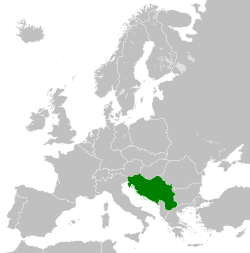Federative People's Republic of Yugoslavia
| Socialist Federal Republic of Yugoslavia | ||||||||||||||||||||
|
Socijalistička Federativna Republika Jugoslavija Социјалистичка Федеративна Република Југославија Socialistična federativna republika Jugoslavija |
||||||||||||||||||||
|
||||||||||||||||||||
|
||||||||||||||||||||
|
Motto Bratstvo i jedinstvo "Brotherhood and unity" |
||||||||||||||||||||
|
Anthem Hej, Slaveni Хеј, Словени "Hey, Slavs" |
||||||||||||||||||||
|
Yugoslavia in 1989
|
||||||||||||||||||||
| Capital | Belgrade | |||||||||||||||||||
| Languages |
Serbo-Croatian Slovene Macedonian Albanian |
|||||||||||||||||||
| Demonym | Yugoslav | |||||||||||||||||||
| Government | Federal one-party socialist republic | |||||||||||||||||||
| President | ||||||||||||||||||||
| • | 1945–1953 | Ivan Ribar (first) | ||||||||||||||||||
| • | 1953–1980 | Josip Broz Tito | ||||||||||||||||||
| • | 1991 | Stjepan Mesić (last) | ||||||||||||||||||
| Prime Minister | ||||||||||||||||||||
| • | 1945–1953 | Josip Broz Tito (first) | ||||||||||||||||||
| • | 1989–1991 | Ante Marković (last) | ||||||||||||||||||
| General Secretary | ||||||||||||||||||||
| • | 1945–1980 | Josip Broz Tito (first) | ||||||||||||||||||
| • | 1989–1990 | Milan Pančevski (last) | ||||||||||||||||||
| Legislature | Federal Assembly | |||||||||||||||||||
| • | Upper house | Chamber of Republics | ||||||||||||||||||
| • | Lower house | Federal Chamber | ||||||||||||||||||
| Historical era | Cold War | |||||||||||||||||||
| • | AVNOJ | 29 June 1943 | ||||||||||||||||||
| • | Proclamation | 29 November 1945 | ||||||||||||||||||
| • | Constitution adopted | 31 January 1946 | ||||||||||||||||||
| • | Balkan Pact signed | 28 February 1953 | ||||||||||||||||||
| • | Death of Josip Broz Tito | 4 May 1980 | ||||||||||||||||||
| • | Disintegration | 27 April 1992 | ||||||||||||||||||
| Area | ||||||||||||||||||||
| • | 1989 | 255,804 km² (98,766 sq mi) | ||||||||||||||||||
| Population | ||||||||||||||||||||
| • | 1989 est. | 23,724,919 | ||||||||||||||||||
| Density | 92.7 /km² (240.2 /sq mi) | |||||||||||||||||||
| Currency | Yugoslav dinar | |||||||||||||||||||
| Internet TLD | .yu | |||||||||||||||||||
| Calling code | +38 | |||||||||||||||||||
|
||||||||||||||||||||
| Today part of |
|
|||||||||||||||||||
| a. | ^ Full name in the Serbo-Croatian and Macedonian languages, written in the Latin alphabet (see Name section for details). | |||||||||||||||||||
| b. | ^ Full name in Serbo-Croatian and Macedonian, written in Cyrillic. | |||||||||||||||||||
| c. | ^ Full name in the Slovene language (Slovene only uses Latin). | |||||||||||||||||||
| d. | ^ There was no de jure official language at the federal level, but Serbo-Croatian was de facto official. It was also legally the official language in the federal republics of Serbia, Croatia, Bosnia and Herzegovina, and Montenegro. | |||||||||||||||||||
| e. | ^ Official in Slovenia. | |||||||||||||||||||
| f. | ^ Official in Macedonia. | |||||||||||||||||||
| g. | ^ Albanian was widely spoken by ethnic Kosovars in the Albanian-majority SAP Kosovo of SR Serbia. It was never made official but it was protected under the 1974 constitution. | |||||||||||||||||||
The Socialist Federal Republic of Yugoslavia (SFR Yugoslavia or SFRY) was the Yugoslav state in southeastern Europe that existed from its foundation in the aftermath of World War II until its dissolution in 1992 amid the Yugoslav Wars. Covering an area of 255,804 km² (98,766 sq mi), the SFRY was bordered with Italy to the west, Hungary to the north, Bulgaria and Romania to the east and Albania and Greece to the south.
It was a socialist state and a federation governed by the League of Communists of Yugoslavia made up of six socialist republics: Bosnia and Herzegovina, Croatia, Macedonia, Montenegro, Serbia, and Slovenia with Belgrade as its capital. In addition, it included two autonomous provinces within Serbia: Kosovo and Vojvodina.
The SFRY traces back to 29 June 1943 when the Anti-Fascist Council for the National Liberation of Yugoslavia was formed during World War II. On 29 November 1945, the Federal People's Republic of Yugoslavia was proclaimed after the deposal of King Peter II thus ending the monarchy. The new communist government originally sided with the Eastern bloc under the leadership of Josip Broz Tito at the beginning of the Cold War, but the SFRY pursued a policy of neutrality after the Tito–Stalin split of 1948, and it became one of the founding members of the Non-Aligned Movement.
...
Wikipedia



